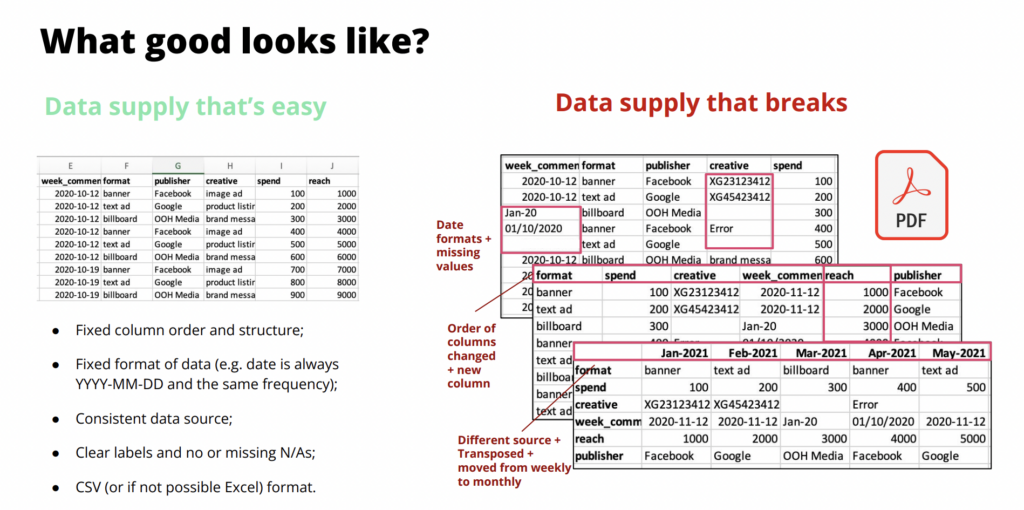The process of marketing mix modeling involves analyzing various marketing data inputs, such as advertising, pricing, promotions, and distribution channels, to understand the impact of these marketing activities on sales and other key performance indicators. However, for accurate and actionable insights, effective data collection and storage play a pivotal role.
In this article, we delve into the best practices for data collection in MMM and storing data for Marketing Mix Modeling, enabling businesses to make informed decisions and drive success.
Define clear objectives for your marketing mix model
Before diving into data collection, you’ll need to define clear objectives for your marketing mix modeling initiative. Identify the specific questions you want to answer and the metrics you aim to measure. if you’re working with Mutinex, the team will help to define these elements as part of your onboarding process. This clarity will guide you in collecting relevant data points and ensure that you focus on information that aligns with your objectives.
Select appropriate data sources
Unlike media mix modeling which only focuses on specific media channels, marketing mix modeling provides you insights into your overall marketing performance. It takes into account the impact of all your marketing tactics (independent variables such as advertising and promotions) and its impact on your sales (dependent variable).
To create a comprehensive and accurate marketing mix model, you’ll need to gather data from multiple sources. This includes internal data, such as sales revenue, pricing data, and promotional calendars, as well as external data, such as market research reports, customer surveys, and competitor insights. By combining both types of data, you gain a holistic view of your marketing efforts and their impact on incremental sales.
Ensure data accuracy and consistency
Data accuracy and consistency are vital for reliable marketing mix modeling. Inaccurate or inconsistent marketing mix modeling data can lead to flawed analyses and misguided decision-making. Implement data validation processes to identify and rectify errors, such as missing values or outliers, before including them in your model. Regularly audit and update your data to maintain accuracy and ensure consistency over time.

Implement robust data collection for marketing mix modeling mechanisms
To streamline the data collection process, consider implementing automated systems and tools. Marketing automation platforms, customer relationship management (CRM) systems, and digital analytics tools can help collect data seamlessly and efficiently. These systems can capture a wide range of data, including customer demographics, campaign performance metrics, and website interactions, providing a rich dataset for analysis. The Mutinex team will work with you to help establish a good data collection mechanism. And our platform, DataOS (which automatically formats data sources) will help to streamline much of the data collection process away from data scientists and into marketing teams.
Preserve data granularity
Maintaining data granularity is essential for accurate marketing mix modeling. Granularity refers to the level of detail at which data is collected and stored. Whenever possible, aim to retain the finest level of granularity, allowing you to capture nuances and variations that might be lost at aggregated levels. This detailed data empowers you to uncover meaningful insights and make precise adjustments to your marketing strategies.
Optimize data storage and accessibility
As the volume of data grows, choosing the right storage solution becomes vital. Consider cloud-based storage options, which offer scalability, flexibility, and enhanced accessibility for the data collected. Cloud platforms provide the ability to store, process, and analyze large datasets efficiently. Additionally, ensure that your marketing and sales data are well-organized and labeled, enabling easy retrieval and analysis when needed.
Establish data governance frameworks
Implementing a data collection and governance framework will help to manage data quality, security, and integrity. Establish clear guidelines and protocols for data collection, storage, and usage. Assign responsibility for data management to individuals or teams within your organization to ensure accountability.


